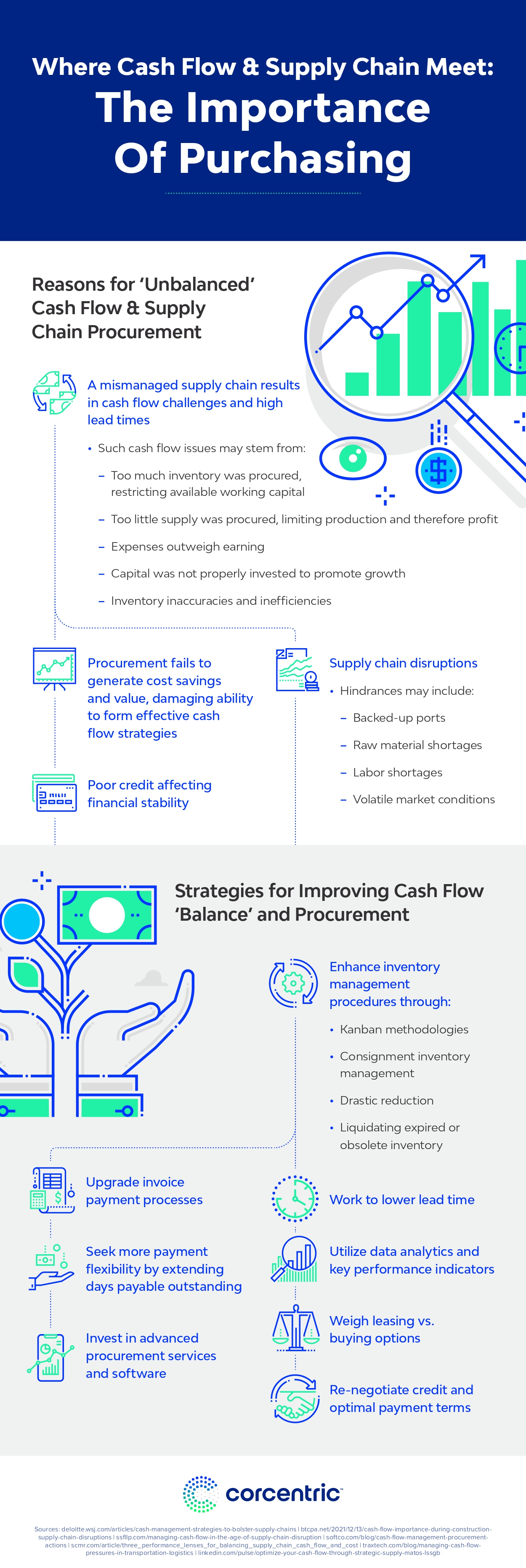Inventory is critical for business because it plays a significant part in the company’s expansion. When inventory is crucial, you must effectively manage it to boost its effectiveness.
The bottom line might be negatively impacted if inventory planning is not done correctly, as it is an essential component of daily operations. Inventory is the final product for some businesses, while it is the raw material for others.
However, several factors influence inventory efficiency. And what are these elements? Read on to learn about these factors.

Infographic Created By Corcentric, Supporting Your Business Goals With Managed Accounts Receivable
What Factors Affect Inventory Planning?
There are several things to take into account when managing your inventory processes. Awareness of how internal and external forces might influence inventory planning is crucial. Let’s examine the primary variables that can impact inventory processing.
Financial Factor
A business cycle involves many financial risks; therefore, making a suitable financial investment is crucial for good inventory planning.
When you budget the costs associated with each stock management task, such as item ordering, stock-related tax expenses, and so on, you will have the choice to proactively manage your inventory planning system and reduce severe financial problems.
The cost of running a warehouse and transportation are two additional financial considerations. You may need to adjust your inventory planning procedures in response to changes in these variables. For instance, fluctuations in fuel prices could force you to reconsider your mode of transportation to save money. Planning inventory will also alter if you buy your trucks or hire other transportation providers.
Lead Time
The lead time is when an item is ordered and when it arrives. Lead times will vary significantly based on the type of product and the different production techniques used. Therefore adjustments to these parameters may necessitate adjustments to inventory planning.
Moving manufacturing operations to foreign nations with cheaper production costs could result in longer wait times. You might need to change your stock levels because producing the same goods locally could cost more but take less time.
Market Demand
Effective inventory planning depends heavily on having a solid understanding of market demand. Given that everything is based on supply and demand.
Because timely product delivery is crucial to maintaining our customers’ satisfaction, demand is something; businesses produce goods in response to customer needs, sometimes in high or low quantity.
Product Types
When considering your inventory’s effectiveness, you must ensure that it is utilized before it expires or becomes damaged. Any inventory can be present, and the various product types in stock must be considered when managing inventory. The shelf life of some products may be shorter than those of others because they are perishable. Inventory control is necessary for this situation to ensure that these items are shifted according to expiration dates.
For instance, fresh produce or food has a limited shelf life in the retail industry before losing its effectiveness. Therefore, the inventory must be maintained and used up before its expiration date.
Suppliers
Suppliers can significantly influence inventory control. Reliable suppliers are necessary for successful firms to budget expenses and organize production. A supplier who is unpredictable or unreliable can have a significant impact on inventory planning. To avoid product shortages or delays in the production process, it can be a good idea to ensure you have a trustworthy backup source.
Because vendors have the most influence over inventory planning, working with the correct one is essential. Organizations may find tracking and managing the supply chain challenges, mainly if they can’t rely on their vendors to deliver quality goods on time.
Inventory Theft
Theft of inventory is one of the most prevalent problems globally, another factor affecting inventory. Employee theft is to blame for 28% of retail inventory losses in the US, as per studies.
For instance, you may believe that merchandise is in stock but discover that it is not where you expected it to be when you check your warehouse, which hurts business.
Service Level
The service level is the likelihood that the next replenishment cycle won’t result in a stockout. The safety stock needed to cover lead times, customer demand, and carrying costs must all be balanced. Safety stock calculations often follow a “one size fits all” approach for all items. These methods lead to the proper amount of inventory for some things, too much for others, and insufficient inventory for others. A statistical strategy needing multiple data items for each item is the calculating method that yields the highest degree of accuracy. Without any planning framework, this approach might be complex.
External Factors
A variety of external sources may impact inventory control. For instance, economic downturns could happen, and you’ll often have little control over them. It is imperative to evaluate the economy to prevent stockouts or an accumulation of excess inventory.
The level of local competitiveness or the state of the real estate markets could be other factors. It is a good idea to regularly analyze the external climate to keep prepared because these aspects are also mainly beyond your control.
Forecast Quality
A demand forecast for inventories may be simple or intricate. In some operations, calculations are straightforward and consider sales and current inventory value for over a year. To forecast the ideal inventory levels, other calculations, such as economic order quantity (EOQ), also require an estimate of annual demand, holding costs, ordering costs, and carrying costs. Regardless of the computation method, the forecast’s accuracy significantly impacts corporate operations. Missed deliveries and production interruptions can result from inaccurate sales calculations and seasonal spikes or dips.
About Fountain9
With the right timing, inventory planning from Fountain9 helps retailers meet customer demand. Their artificial intelligence (AI)-powered inventory planning software, Kronoscope, can precisely forecast demand for each SKU item and identify the quantities that should be stocked to meet demand satisfactorily. Kronoscope considers all the factors influencing inventory planning and helps businesses stock items to optimal levels.

